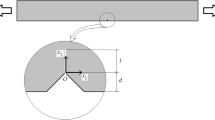Abstract
The stress concentrations that occur at inclusions due to thermal expansion and elastic modulus mismatch are discussed and the stress intensity factors at interface cracks that result from these stresses are calculated. It is shown that conservative failure prediction based on an equivalence between inclusion size and crack size is usually acceptable if the shear modulusμ or thermal expansion coefficientα for the inclusion is larger than the matrix values. If, however,μ andα are smaller for the inclusion than the matrix, extensive cracking can develop at the inclusions which may lead to premature failure. For this case the only effective methods for failure prediction are techniques which give directly the maximum stress intensity factor, i.e., proof testing and/or acoustic emission.
Similar content being viewed by others
References
Work performed at Westinghouse Laboratories byF. F. Lange andR. Kossowsky, published in ARPA report, “Brittle Materials Design, High Temperature Gas Turbine,” AMMRC CTR73-9 (March 1973).
H. R. Baumgartner andD. W. Richerson, in “Fracture Mechanics of Ceramics” (Plenum Press, New York, 1974) Vol 1, p, 367.
A. G. Evans andS. M. Wiederhorn, NBSIR 73-147 (March 1973);Intl. J. Frac., in press.
C. F. Tiffany andJ. N. Masters,ASTM STP,381 (1964) 249.
D. Weyl,Ber. deut Keram. Ges. 36 (1959) 319.
J. Selsing,J. Amer. Ceram. Soc. 44 (1961) 419.
M. V. Speight andR. C. Lobb,Met. Trans. 3 (1972) 737.
J. N. Goodier,J. Appl. Mech. 1 (1933) 39.
P. C. Paris andG. C. Sih,ASTM, STP 381 (1964) 30.
S. Vaidyanathan andI. Finnie,Trans. ASME, June 1971, p. 242.
E. R. Fuller andA. G. Evans,Met. Trans. to be published.
R. W. Davidge andT. J. Green,J. Mater. Sci. 3 (1968) 629.
A. S. Tetelman andA. G. Evans, in “Fracture Mechanics of Ceramics” (Plenum Press, New York, 1974) Vol. 2, p. 895.
R. J. Lumby andR. F. Coe,Proc. Brit. Ceram. Soc. 15 (1970) 91.
A. G. Evans andJ. V. Sharp,J. Mater. Sci. 6 (1971) 1292.
Materials produced at Norton Company and Westinghouse, and reported in [1].
S. Prochazka andR. J. Charles, in “Fracture Mechanics of Ceramics” (Plenum Press, New York, 1974) Vol. 2, p. 579.
Author information
Authors and Affiliations
Rights and permissions
About this article
Cite this article
Evans, A.G. The role of inclusions in the fracture of ceramic materials. J Mater Sci 9, 1145–1152 (1974). https://doi.org/10.1007/BF00552831
Received:
Accepted:
Issue Date:
DOI: https://doi.org/10.1007/BF00552831




